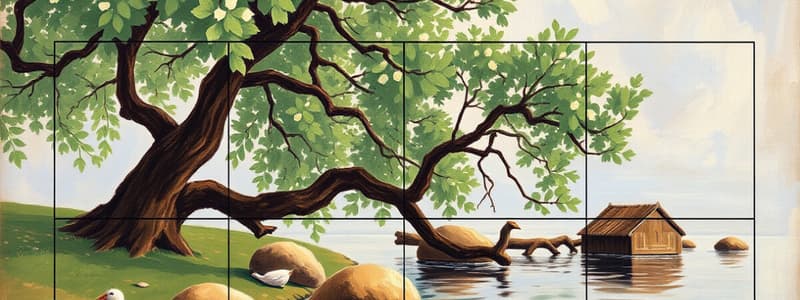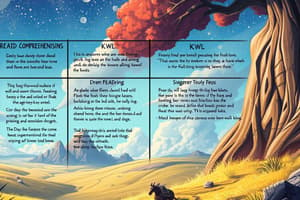Podcast
Questions and Answers
What is the purpose of using a KWL chart in reading comprehension?
What is the purpose of using a KWL chart in reading comprehension?
- To organize thoughts and inquiries about the text. (correct)
- To summarize the entire text in one statement.
- To identify the author's background.
- To analyze the grammatical structure of sentences.
What does visualization in reading primarily help with?
What does visualization in reading primarily help with?
- Analyzing the financial aspects of a narrative.
- Creating mental images to enhance understanding. (correct)
- Summarizing chapters into brief paragraphs.
- Memorizing the entire text from start to finish.
Which of the following strategies is NOT a part of the reading comprehension methods discussed?
Which of the following strategies is NOT a part of the reading comprehension methods discussed?
- Reading the passage only once. (correct)
- Questioning the author while reading.
- Rereading the passage for better understanding.
- Analyzing the author's use of imagery.
What is a recommended starting point when reading a passage for the first time?
What is a recommended starting point when reading a passage for the first time?
Which reading strategy enhances both inquiry and personal engagement with the text?
Which reading strategy enhances both inquiry and personal engagement with the text?
What role does a thesis statement play in an essay?
What role does a thesis statement play in an essay?
Which of the following is an example of understatement?
Which of the following is an example of understatement?
What should each topic sentence in an essay do?
What should each topic sentence in an essay do?
How can transitions improve the quality of writing?
How can transitions improve the quality of writing?
Which literary device is characterized by a purposefully biting tone?
Which literary device is characterized by a purposefully biting tone?
What is the primary purpose of visualization before reading?
What is the primary purpose of visualization before reading?
What are dynamic characters known for?
What are dynamic characters known for?
Which component of a story's plot is characterized by high tension and a turning point?
Which component of a story's plot is characterized by high tension and a turning point?
What distinguishes intensive reading from skimming?
What distinguishes intensive reading from skimming?
How does characterization contribute to a character's development in a story?
How does characterization contribute to a character's development in a story?
In which type of setting does the time of the story play a critical role?
In which type of setting does the time of the story play a critical role?
What does the term 'conflict' refer to in a plot?
What does the term 'conflict' refer to in a plot?
What is the primary purpose of symbolism in literature?
What is the primary purpose of symbolism in literature?
Which of the following best describes a dynamic character?
Which of the following best describes a dynamic character?
What differentiates a metaphor from an allegory in literature?
What differentiates a metaphor from an allegory in literature?
How does the tone of a story differ from its mood?
How does the tone of a story differ from its mood?
In which point of view is the narrator limited to the inner thoughts of only one character?
In which point of view is the narrator limited to the inner thoughts of only one character?
What is a connotation in the context of literary analysis?
What is a connotation in the context of literary analysis?
Which of the following statements about themes in literature is true?
Which of the following statements about themes in literature is true?
What does it mean to contrast ideas in literature?
What does it mean to contrast ideas in literature?
Which adjective would describe the mood of a story?
Which adjective would describe the mood of a story?
What is the role of the setting in a story?
What is the role of the setting in a story?
Flashcards are hidden until you start studying
Study Notes
Reading Comprehension Strategies
- KWL chart and close reading enhance comprehension through pre-reading and rereading.
- Focus on main ideas and student engagement through inquiry fosters interest in texts.
- Analyze author's use of imagery, word choice, tone, voice, and structure.
Effective Reading Techniques
- Read passages multiple times to deepen understanding; first reading identifies the main idea.
- Topic sentences often reveal primary themes; ask questions to clarify understanding.
- Questions can include: "Who?", "What?", "Where?", "When?", "Why?", and "How?".
Visualization in Reading
- Visualization creates mental images, helping readers connect with and comprehend texts.
- Incorporates all five senses for a complete understanding of characters and settings.
- Visualization aids in predicting, monitoring, and recalling reading content.
Types of Reading Strategies
- Skimming provides an overview without in-depth reading; scanning seeks specific information.
- Intensive reading focuses on details line by line, while extensive reading is for general pleasure or information.
Elements of Plot in Fiction
- Basic plot elements include exposition, conflict, rising action, climax, and resolution.
- Subplots enhance the main plot and character development, adding depth to the story.
Understanding Characters
- Characters drive the plot and can be classified as major, minor, protagonist, antagonist, dynamic, or static.
- Characterization reveals traits through direct (telling) or indirect (showing) methods, often including dialogue.
Setting in Literature
- Setting encompasses the time, place, and circumstances in which a story occurs.
- Authors utilize imagery and exposition to establish settings, which can be backdrop, temporal, environmental, or individual.
Themes and Central Ideas
- Central ideas reflect the life lessons conveyed in literature, often embodying multiple themes.
- Examples include moral lessons from fables, illustrating the thematic depth in storytelling.
Symbolism in Literature
- Symbolism employs persons, situations, or objects to represent broader ideas, enhancing emotional connection.
- Types of symbolism include metaphors (comparisons) and allegories (extended metaphors throughout the narrative).
Narrative Voice and Point of View
- Various points of view include first-person, second-person, third-person limited, omniscient, and objective.
- The choice of perspective significantly affects how readers experience the story.
Mood and Tone
- Mood conveys the reader's emotional response while tone reflects the author's attitude about the subject.
- Techniques like figurative language, setting, and character types help convey mood and tone.
Comparing and Contrasting in Literature
- Comparing identifies similarities and differences; contrasting highlights only differences.
- Use graphic organizers like Venn diagrams for clarity and structure in analysis.
Figurative Language
- Figurative language adds depth, meaning, and emotion beyond literal definitions with devices like metaphor, simile, and personification.
- Effective use is situational, emphasizing emotional resonance without overuse.
Understanding Understatement
- Understatement minimizes the significance of a situation or characteristic, often for comedic or ironic effects.
- Litotes, a form of understatement, negates the opposite to convey meaning.
Formal Essay Structure
- Typical structure includes an introduction, body paragraphs, and conclusion, often framed around a thesis statement.
- Thesis statements provide a central argument, supported by topic sentences in body paragraphs.
Crafting Strong Introductions and Conclusions
- Introductions should include a thesis statement and relevant background; conclusions summarize and reinforce main points.
Body Paragraph Development
- Body paragraphs must be well-developed with supporting details, adhering to the topic sentence's main idea.
- Ensure coherence and transition between points to maintain clarity and logical flow.
Transitioning Between Ideas
- Transition words and phrases aid in the smooth progression of ideas, connecting sentences, paragraphs, and sections effectively.
- Choosing appropriate transitions depends on the nature of the relationship being conveyed.### Importance of Evidence in Writing
- Use evidence to strengthen arguments; mere opinions rarely convince readers.
- Incorporate examples, facts, statistics, and other types of evidence for credibility.
- Clarify the relevance of evidence to the argument, as connections may not be evident to all readers.
Staying On-Task in Essay Writing
- Address the essay prompt directly; ensure responses align with what is being asked.
- Identify key terms to determine whether to argue, analyze, or provide another type of response.
- Create a one-sentence summary of your argument to guide the essay and develop into a thesis statement.
- Outline major points to maintain focus; prevents straying into irrelevant tangents.
- Edit by removing off-topic information or integrating necessary points as needed.
Writing Process for Organization
- Follow the structured writing process: brainstorming, outlining, drafting, and revising/editing.
- Consider the intended audience and purpose to give writing direction and clarity.
- Organizing thoughts through these steps enhances efficiency and completion of writing tasks.
Studying That Suits You
Use AI to generate personalized quizzes and flashcards to suit your learning preferences.




